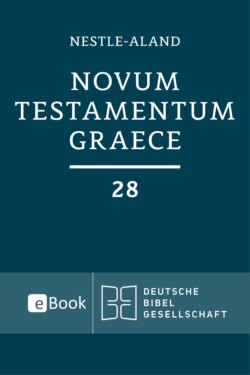Читать книгу Novum Testamentum Graece (Nestle-Aland) - Группа авторов, Nestle-Aland - Страница 63
4. The Church Fathers
ОглавлениеFrom the beginning of critical work on the text of the Greek New Testament citations by early Christian writers have played a prominent role in research on textual history. As the lives and works of the Church Fathers are fairly well defined both geographically and historically, their witness is highly significant for the history of the New Testament text and for the reconstruction of its initial form. In textual criticism they are particularly relevant as indirect witnesses to the manuscripts they used. Consequently, modifications of the New Testament text that can be attributed to their way of quoting or to the manuscript tradition of the text containing the quotation have to be excluded from the apparatus of a hand edition of the New Testament.
As before, patristic quotations have been treated rather selectively in the present 28th edition. They are cited only if they can be considered reliable witnesses to the text of the manuscripts quoted.
In this respect no significant changes to the Nestle-Aland 27 apparatus were necessary, since a thoroughgoing revision had been carried out for that edition. Notes referring to patristic citations were simply checked, and required correction in a few cases only. However, for the Catholic Letters the patristic apparatus entries were checked and supplemented according to the ECM.
Authors whose quotations are known only indirectly through the writings of another Father have their source indicated in superscript (cf. Mar[cus/Marcosii]Ir). The only exception to this rule is the Gnostic Theodotus, who is cited as ClexThd, because it is difficult to distinguish between the original quotation and the editorial hand of Clement in his Excerpta ex Theodoto.
The sources of quotations attributed to Marcion are always identified with a superscript indicating whether they derive from Tertullian, Epiphanius, or Adamantius (cf. McionT/E/A). This assists the reader in making an independent evaluation of the evidence in a textual tradition recognized for its difficulties. The problems concerning the original wording of Marcion's text still remain unsolved. In the present edition of the Novum Testamentum Graece Marcion's quotations are derived essentially from the sources named above. Only occasionally are quotations from Marcion taken from other Greek or Latin writings.
The quotations of Latin Fathers are treated in a similar fashion. Patristic evidence through the 8th century has been included for the more important writers.
The following signs and abbreviations are used for patristic evidence:
( )
( ): The quotation supports the given reading, but with some slight variation.
ms, mss
ms, mss: The Father indicates knowledge of one or more New Testament manuscripts supporting the given reading.
txt/com
txt/com: In citing patristic commentaries the distinction is drawn between the text commented on (txt), called the lemma, and the text of the Father ascertained from the commentary proper (com).16
lem
lem: The reading represents the lemma, i.e., the running biblical text of a commentary. This sign is used when the text of a Father cannot be reconstructed from the commentary proper, and advises a degree of caution.
pt/pt
pt/pt (partim/partim): The Father cites the particular passage more than once and in more than one form. This sign comprises a complementary pair, and both elements are always shown whenever possible. When one is not shown, this is either because the evidence for the reading in the text is not cited in the apparatus, or because the Father is witness to a further reading which is not cited in the apparatus.
vid
vid (videtur): The witness of a Father for the reading given is probable, but not completely certain.
v.l.
v.l. (varia lectio): In the manuscript tradition of the Father, one or more manuscripts support the reading given.
1739mg
1739mg: Patristic evidence noted in the margin of the Greek manuscript 1739 (e.g., Eph 3,18).
